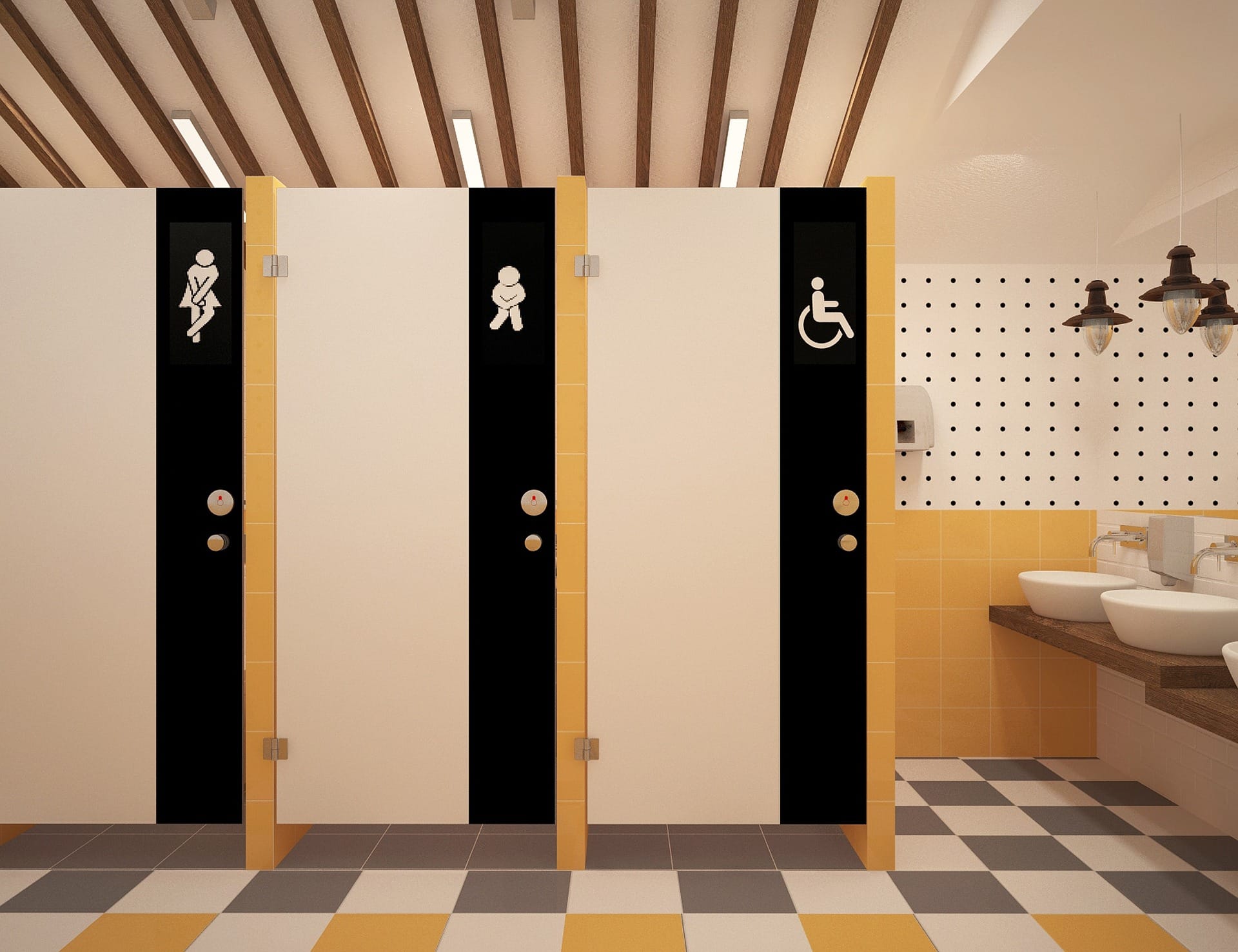It is widely believed that public toilets are a real breeding ground for all sorts of pathogens, including sexually transmitted diseases. We decided to check whether such fears were justified.
About the dangers of public toilets write V Media, blogs, on websites with questions and answers and forums. On the Internet even can be found instructions like “How to go to a public toilet without getting an infection.” On various resources users are discussingHow to protect yourself when visiting such bathrooms - for example, cover the seat with toilet paper. Marketplaces, in turn, offer many options for disposable pads toilet.
An important characteristic of any infection is the route of its transmission. All of them share into artificial and natural. The first group includes transfusion (associated with blood transfusion) and injection routes, as well as transmission during diagnostic and therapeutic procedures. Obviously, no one performs medical procedures or performs medical injections in a public toilet (we will deal with injection drug users a little later). Natural paths, in turn, are divided into generic, horizontal and vertical. In birth transmission, the infection is transmitted from the mother to the fetus during the passage of the birth canal. The vertical route of transmission of infection is also called transplacental, that is, transmission occurs from mother to fetus during pregnancy. This route also includes transmission of infection to the child during breastfeeding. Neither of these two routes involves another carrier of infection other than the mother of the unborn child. Only horizontal ones remain, which, in turn, are divided into five more types:
- transmission;
- airborne;
- fecal-oral;
- blood-contact;
- contact.
Let's deal with each of them in turn. Transmissible pathway is the route in which the pathogen enters the body through the bite of an insect or animal. Diseases transmitted in this way include malaria, dengue, chikungunya, Zika virus disease, West Nile fever, Japanese encephalitis (all carried by mosquitoes), tick-borne encephalitis (carried by ticks). In general, the risk of being bitten by an insect that carries the disease is approximately the same for a person sitting on a public toilet and for a person sitting at a cafe table. Therefore, you should not be afraid of contracting, for example, malaria while using a public toilet.
The second route of transmission is airborne. This way spread acute respiratory viral infections, influenza, COVID-19, chicken pox, scarlet fever, meningococcal infection, etc. At the same time, the risk of catching viral colds transmitted by airborne droplets depends not on the place, but on the number of people and the distance between them. For example, the influenza virus, which is spread when an infected person coughs or sneezes, can easily overcomes distance up to 1 m. The chickenpox virus is even more “long-range” - it spreads 20 m from an infected person. That is, in this case, a separate stall of a public toilet as a whole may be even safer than a bus, where passengers are not separated from each other by any partitions.
Another class of diseases are infections with a predominantly fecal-oral route of transmission, when the causative agent of the infection is located mainly in the gastrointestinal tract, is released into the external environment with feces and enters a new organism through the mouth. There are three types of fecal-oral transmission: water (for example, when a person swims in a body of water infected with enterovirus infection Maybe accidentally swallow some water and get sick), nutritional (for example, eating foods contaminated with Salmonella bacteria, Maybe lead to salmonellosis) and, finally, contact-household (extremely common in children - for example, when licking toys and sucking fingers). Obviously, since pathogens are released into the environment along with feces, their concentration in a public toilet should be much higher than in any other place. That is why we are all taught from childhood to wash our hands after going to the toilet, and in the case of a public toilet to do this especially carefully. However, sitting on a public toilet itself does not increase the risk of infection in any way, since in order to infect the body the pathogen must enter the mouth. Therefore, as long as you do not lick or lick a public toilet and wash your hands thoroughly, the risk of contracting an infection through the fecal-oral route of transmission in a public toilet is almost the same as in other public spaces.
The fourth route of transmission is blood contact (in the Russian tradition it is also called parenteral, that is, intravenous), it involves contact with the blood of an infected person. Infections such as HIV, hepatitis B and C can be transmitted through blood contact. For infection, it is necessary that the blood of an infected person enter the body of a new carrier through damaged areas of the skin and mucous membranes. The infection can also be transmitted through the use of a non-disposable syringe between injection drug users. It is important to remember that HIV is transmitted through blood contact only if there are lesions on the skin, touching the blood of an infected person with intact skin no does not pose any danger. It was also not recorded cases transfers hepatitis B or C via seat toilet. And although there is no scientific evidence that you can become infected with bloodborne infections through the toilet seat, if it is covered in blood, then it is still better not to sit on it.
The last type of horizontal transmission of infections is contact. Pathogens in this case are located on the skin, mucous membranes of the eyes, mouth or genitals and can enter the skin or mucous membranes of another person directly (through handshakes, touches, kisses) or indirectly, through touching contaminated (that is, contaminated with a pathogen) objects: clothes, toys, door handles, handrails or, for example, a public toilet seat. This is how scabies, pediculosis, genital herpes, various fungal infections (for example, lichen) and most sexually transmitted infections (STIs, also called sexually transmitted diseases) are spread: syphilis, gonorrhea, trichomoniasis, HPV, HIV, chlamydia, etc.
However, not everything is so scary here. Scabies transmitted through long (15–20 minutes) skin-to-skin contact and is almost not transmitted through shared things. In 1940, a study was carried out in Great Britain experiment: 272 volunteers slept in a bed previously occupied by a patient with scabies, only four of them became infected as a result. Scientists converge on opinionthat the risk of scabies transmission through common objects, including the toilet seat, although possible, is extremely unlikely. The story is similar with pediculosis - lice, carriers of the disease, simply do not live on a surface such as a toilet seat. For the transmission of pediculosis also required prolonged contact with a patient or the use of shared hair care items, hats, and underwear. Risk get infected fungal diseases from the toilet seat are also extremely insignificant. In general, fungal spores can be found on any objects (clothing, upholstered furniture, door handles, etc.), but most often fungi spread in swimming pools, gyms, saunas and beauty salons. Getting infected with genital herpes is also almost impossible through common objects, with the exception of shared sexual toys, since the virus quickly dies in the external environment.
The situation is similar with the possibility of contracting sexually transmitted diseases through the toilet seat. HIV not transmitted neither through this nor through other objects. It is absolutely safe to enter a booth after an HIV-positive person, as well as to drink and eat from the same container. Other STI Same are not transmitted through seat toilet. How jokes Abigail Salyers, president of the American Society for Microbiology: “To my knowledge, no one has ever gotten an STI on a toilet seat unless they had sex there.” In a similar way speaks out and the famous pediatrician Evgeny Komarovsky: “In the overwhelming majority of cases, sexually transmitted diseases are not found on the toilet in a public toilet. They are in other places. Is it possible to get infected? Well, theoretically, if you have a wound on your buttock, this wound comes into contact with a dirty toilet, then you can get an infection. But to imagine that you got syphilis, gonorrhea and chlamydia while sitting on the toilet is just a huge fairy tale!”
According to data Filtrated, a sports training company, found that when lifting free weights in a public gym, a person comes into contact with 362 times more bacteria than what they come into contact with while sitting on a public toilet.
Some people, concerned about getting an infection from touching a public toilet seat, choose instead to “hover” over it without touching the seat with their buttocks. Doctors warnthat this approach is extremely unhelpful. Muscle tension in this position can lead to incomplete emptying of the bladder, which in turn can increase the frequency and urgency of urination, and can also lead to prolapse (protrusion) of the pelvic organs.
However, the seat itself is often not the dirtiest part of the toilet. When flushing with the lid open, germs spread and settle around - on the floor, door, handle and paper holder. That's why recommended flush only with the lid closed or leave the booth immediately after pressing the drain button if the lid is not provided by the design.
Thus, the public toilet seat can be considered safe. It is impossible to contract either STIs or viral hepatitis through it, washing your hands after visiting the toilet can easily protect you from various intestinal infections, and the risk that someone sneezes in the toilet and infects you with ARVI is about the same as that of this happening in any other public place. In addition, hanging over the toilet is anatomically harmful and can lead to unpleasant health consequences. Therefore, if the public toilet seat is clean and dry, then you can safely sit on it.
Cover image: Image Victoria_Watercolor from the site Pixabay

Not true
If you find a spelling or grammatical error, please let us know by highlighting the error text and clicking Ctrl+Enter.






